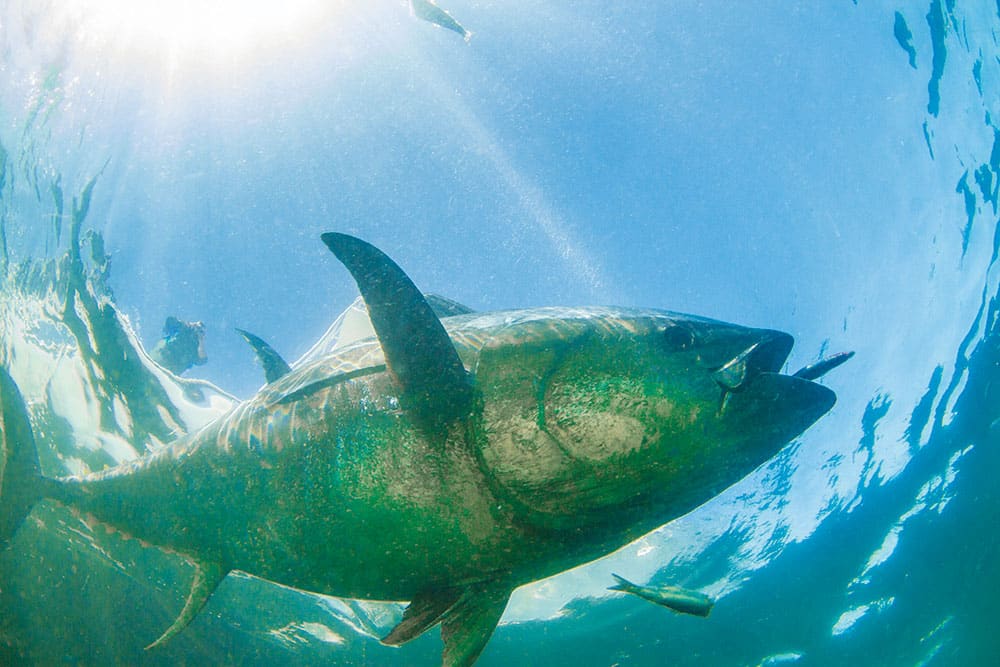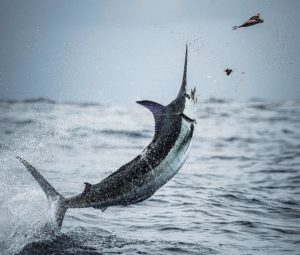
Bluefin Tuna_Adrian
Bluefin tuna garner substantial attention from sushi lovers and the mainstream media, but they also provide tremendous thrills for anglers. From the tried-and-true fishing grounds in the Outer Banks of North Carolina to the growing popularity of the Nova Scotia fishery, trophy bluefin tuna are one of those lifetime fish that anglers, including myself, lie awake at night dreaming of catching. Thankfully, management decisions and recent scientific findings might actually give Atlantic bluefin tuna a brighter future than in the past.
The finalization of Amendment 7 during the fall of 2014 will provide benefits, both direct and indirect, for the sport-fishing community. Being intricately involved in the process both as a member of the Highly Migratory Species Advisory Panel and in my previous post at The Billfish Foundation, these developments should give hope to the doom and gloom often heard in connection with fisheries management.
Over the past several summers while working many of the big-money tournaments in the northern Gulf of Mexico, I heard handfuls of captains and owners champing at the bit for the opportunity to catch and land a trophy bluefin tuna. Who could blame them? They were experiencing and hearing stories about spooled 80s and 130s after bluefin crashed marlin spreads, and accounts of feeding frenzies where bluefin tunas the size of VW buses sprayed chicken dolphin through the air as they launched themselves in hot pursuit. That’s a thought that gives me chills.
The resulting desire in the Gulf to legally land one has been at an all-time high. The trophy bluefin (greater than 73 inches) closed early in recent years due to federal closures after the quota was caught by the boys in North Carolina. Should the opportunity arise, however, many of these Gulf anglers would likely take the potential slap on the wrist from the National Marine Fisheries Service (NMFS) and land the fish rather than let it go. Sure, not all of us would be willing to do the same, but the message was apparent: Things needed to change.
Amendment 7 primarily focused on a large shake-up in how commercial bluefin fisheries are managed. Resulting also was the separate trophy sub-quota for anglers in the Gulf of Mexico that became effective the first of this year. This inevitably will create controversy in itself because the Gulf is one of the only known spawning grounds for western Atlantic bluefin tuna. However, keep in mind that this quota was not pulled from out of a hat or allocated arbitrarily; rather, it was shifted within the overall recreational quota already in place. While the need for additional recreational quota is a topic for another column, it might come with time.
The Gulf quota will only be three to four fish, but what needs to be remembered is that some is far better than none if the fishery is closed. Resulting with it are more opportunities created for anglers. The quota is quite slim, however, compared to the amount of commercial discards of bluefin where between 2005 and 2013, about 970 fish on average were discarded annually by the U.S. fleet. For those trying to equate recreational to commercial landings in the Gulf is along the lines of relating an anthill to a sand dune.
Even more important are the indirect benefits generated from changes in how the commercial bluefin tuna fisheries are managed through Amendment 7. As I mentioned before, domestic Atlantic bluefin management was -completely turned on its head with the primary focus of increasing accountability among all user groups. In doing so, one of NMFS’s primary goals is to reduce the wasteful practices of discarding bluefin tuna in the pelagic longline fishery in order to adhere to international recommendations.
If we look at the whole picture over the last several years, both live and dead bluefin tuna have been discarded at alarming rates due to regulatory constraints while fishing for other -species like yellowfin tuna or swordfish. These extremely wasteful practices and the validity of numbers reported by this fishery are questionable at best. The NMFS catch summaries show bluefin -discards have seen a sharp decline over the last five years. Is it happenstance that this occurred during the same time period in which Amendment 7 was being developed? If this truly is the case, a pat on the back is deserved to those crews for -getting better at avoiding bluefin.
Unfortunately, I don’t think this is reality, but rather a sign of the times with boats failing to report their interactions with bluefin due to uncertainty in how management decisions would unfold. As Amendment 7 developed, commercial boats were graded on -several different factors and given a grade depending on the outcomes. NMFS then used each vessel’s grade to allocate quota to that vessel — the better the grade, the more bluefin quota assigned. This is important because for longline vessels to fish in the newly established Individual Bluefin Quota (IBQ) system, they must each have a sufficient quota of bluefin tuna in order to leave the dock.
If a vessel uses its entire quota by catching bluefin (they are now required to retain all legal-size fish), they are not permitted to keep fishing. Before they can leave for another trip, the vessel must both pay back any overage of quota as well as acquire enough to take a subsequent trip. Vessels can sell, buy, or trade quota with each other throughout the season, but depending on market factors, it is inevitable that boats will have their season cut short. Vessels are also required to have video cameras rolling at all times in hopes of recording all of their catches, including bluefin interactions. The overall goal of the new management system is to make each individual boat accountable, and with it, indirect benefits should result for big‑game fishing. Let’s hope it works.
How these management decisions impact billfish will be extremely important to all of us in the sport-fishing community. The effectiveness of the IBQ system comes into play when longline boats get pulled off the water as they run out of quota and can no longer set hooks that could potentially catch billfish. Marlin and sailfish are barely mentioned in the documents creating Amendment 7, but there has been an alarming increase in the number of billfish discards over the last five years. Keep in mind, this is the same time frame in which bluefin tuna interactions have plummeted. In 2013 alone, the last year in which data is available, 844 blue marlin, 1,239 white marlin, 456 sailfish, and 342 spearfish were discarded by the U.S. longline fleet. Some would say that this is a sign that billfish populations are thriving due to increased catches and the bluefin stocks are in danger because less are being caught. But looking at stock assessments and recent scientific findings, the writing on the wall says otherwise, and there are other factors at play.
Aside from a buyout of the longline fleet to get them off the water, the new regulations in Amendment 7 do brighten the horizon for big-game fishing. The benefits from current closed zones combined with the new gear-restricted areas, electronic monitoring, the IBQ system and other management measures in Amendment 7 will provide a promising future. Just remember: We can’t go out there chunking or trolling to specifically target bluefin in the Gulf. But if one jumps on your marlin lure or live bait while fishing a rig, it’s game on!







